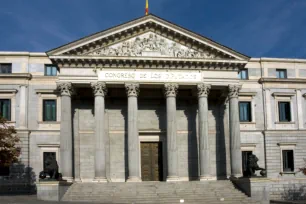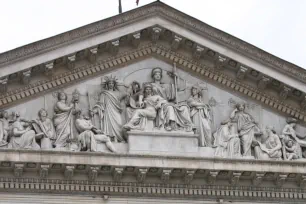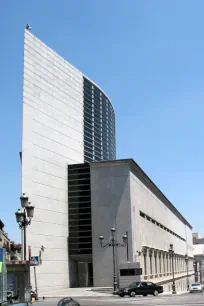The Palacio de las Cortes was built in the nineteenth century as the seat of the Cortes, the Spanish parliament. The monumental building is home to the Congreso de los Diputados, the lower house of the parliament.

The history of the Cortes Generales, or Cortes in short, goes back to the eleventh century, when it was an assembly of clerical and nobility advisors who assisted the Castilian king. In the early nineteenth century the Cortes evolved into a modern and independent parliament and in 1812 it created the Spanish constitution.
The current parliament, consisting of a lower house – the Congreso de los Diputados (congress of deputies) – and an upper house – the Senado (senate) – is based on the constitution of 1978, which was created after the death of dictator Franco in 1975. The lower house is seated in the Palacio de las Cortes, while the upper house is seated in the Palacio del Senado, near the Plaza de España.
The building

The Palacio de las Cortes is an imposing building with a Neoclassical front facing a triangular square, the Plaza de las Cortes.
The main entrance is flanked by bronze lions and framed by a large portico. The pediment is decorated with statues created by Ponciano Ponzano. It shows an allegorical representation of Spain with the constitution accompanied by statues that represent justice, courage, fortitude, harmony, science, arts, rivers, trade, agriculture, abundance and peace. This ornate entrance is only used once a year, when the Spanish king officially opens the parliamentary year.

The building was constructed between 1843 and 1850 at the site of the Convento del Espíritu Santo, which burned down in 1823. It was carried out to designs by architect Narciso Pascual Colomer, a native of Valencia. The lions at the entrance were added in 1866.
The interior is dominated by a large semicircular assembly hall. In 1850, the ceiling was decorated with a painting by Carlos Luis de Ribera. It depicts several historical Spanish figures, including Columbus, Velázquez, Cervantes and queen Isabel II. There are also some bullet holes visible in the ceiling, a reminder of the failed coup of 1981, when right wing officers led by colonel Tejero held the deputies hostage.
In 1990 an extension of the Palacio de las Cortes was erected adjacent to the historic building. The new wing, designed by Rubert de Ventos, Oriol Clos and Josep Parcerisa, features a modern design with plenty of curving glass and natural stone, in stark contrast with the Neoclassical architecture of its neighbor.
- Next: Atocha Station
- More Sights & Attractions in Madrid

